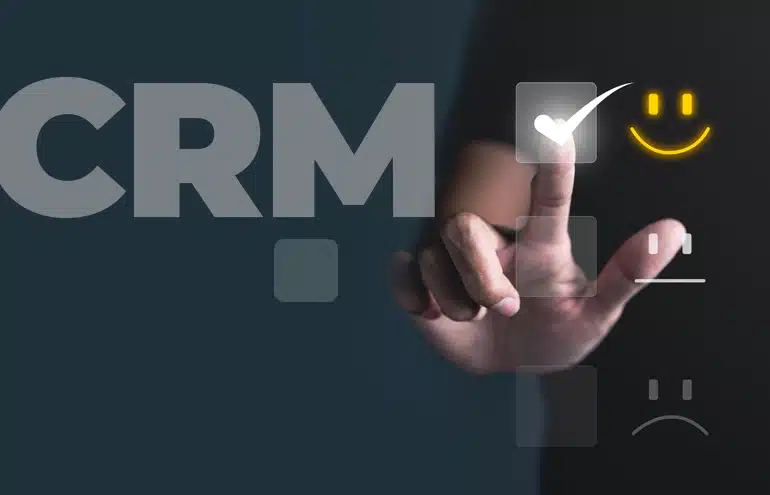The best technology is the one you use. Here’s how Ruth Carter switched from using a traditional CRM database for their solo practice to using Google Contacts.

Table of contents
When I was preparing to start my solo practice in 2011, I bought the customer relationship management database Act!, following a suggestion from my business mentor. I bought it at Staples, and it came on a CD, as software did back then.
Early in my practice, I went to networking events every week, exchanged business cards with other attendees, and when I got home, I meticulously entered all their information into my database. I also sent each of them a follow-up email that said it was lovely to meet them and to reach out if they ever needed help with business, intellectual property or internet law.
My CRM Became a $400 Per Year Digital Dust Collector
As my business grew, I attended fewer and fewer networking events. And once I joined Venjuris as Of Counsel, I rarely needed to use my CRM for conflicts checks because the firm had its own database of current and previous clients. Also, I keep my newsletter, Ruth & Consequences, completely separate from my CRM. I send it out using Mailchimp, and everyone has to add themselves to the distribution list. I never add anyone to this email list without their explicit request. (Putting people on your email list without their consent is disrespectful — and may be illegal. Don’t do this.)
Eventually, Act!, like many software companies, stopped selling its software on CDs and required its customers to pay a monthly or annual fee to continue to use the product. Over time, the only time I thought about my database was when I received the reminder that my software license was up for renewal.
By 2022, I was paying about $400 per year for a database I wasn’t using. It was a digital dust collector. The problem wasn’t that Act! isn’t a good product. I appreciated that it had fields to add notes and set reminders. Particularly, I liked that it had the ability to create lists, so I could easily keep a list of other lawyers and prospective clients, as well as my blackball list (people who aren’t allowed to hire me and to whom I’ll never refer work).
The problem was I wasn’t using it. So, I gave myself a deadline: If I wasn’t using my database within a year, I would cancel the license and find something I would use.
Selecting My New Digital Rolodex
Earlier this year, I asked my friends, several of whom are entrepreneurs, what they use for their contacts. I wanted something cloud-based, but I knew I didn’t need a fancy CRM overflowing with extra bells and whistles.
Surprisingly, several people recommended Google Contacts, the basic CRM that shows up in your Gmail sidebar. (You can also download it as an app or use it as part of Google Workspace.)
Google Contacts … what a simple solution.
I have two Google accounts — one that’s free and one that’s nearly free — and I use an Android phone. I’m already using Google Contacts for my personal life, so it would be easy to build on what’s already working.
Switching from Act! to Google Contacts would mean giving up the few things I liked about Act! — especially the lists. However, since I wasn’t even opening my database, these features weren’t adding any value to my life.
The Drudgery of Moving Contacts
Changing from Act! to Google Contacts required the brain-numbing task of systematically going through the 5,000-plus contacts in my database. It took weeks. I essentially had an entry for every person I met at every networking event for years.
Note to self: Figure out a better system for determining who gets to be in your CRM. A brief conversation isn’t enough.
After dozens of hours of scrolling through screen after screen of contacts I mostly didn’t recognize, I noticed Act! has a feature that will export your contacts to an Excel spreadsheet. With a sigh of relief, my work became so much faster, quickly skimming and deleting the entries I didn’t recognize. I probably deleted 80% to 90% of them.
Google Contacts + LinkedIn
With the remaining entries, I created new contacts in my Google Contacts. Likewise, if I wasn’t already connected with them on LinkedIn, I requested them as a connection. It’s not a perfect system, but it’s more than sufficient for what I need. Google Contacts has the basic information I need, and LinkedIn fills in many of the details I might need to know about them.
Now, when someone asks me for a recommendation for a professional to hire, I do a quick search on LinkedIn. Most of the time, someone asks for a recommendation for a lawyer who practices an area of law I don’t do, or in a geographic area where I’m not licensed. Usually, searching for [practice area] + “lawyer” and filtering the results to only show the geographic area is sufficient to give a referral.
What About My Blackball List?
I still have my blackball list; I added those people to my Google Contacts as well, but I entered their last names as “Blackball” + [Last Name]. And I didn’t request them as connections on LinkedIn.
What CRM Do You Use?
What about you? How do you keep track of your contacts? I’d love to hear what is working for you.
Related: “Why Every Solo Lawyer Needs a CRM” by Andrew Lacy.
Image © iStockPhoto.com.

Sign up for Attorney at Work’s daily practice tips newsletter here and subscribe to our podcast, Attorney at Work Today.
















